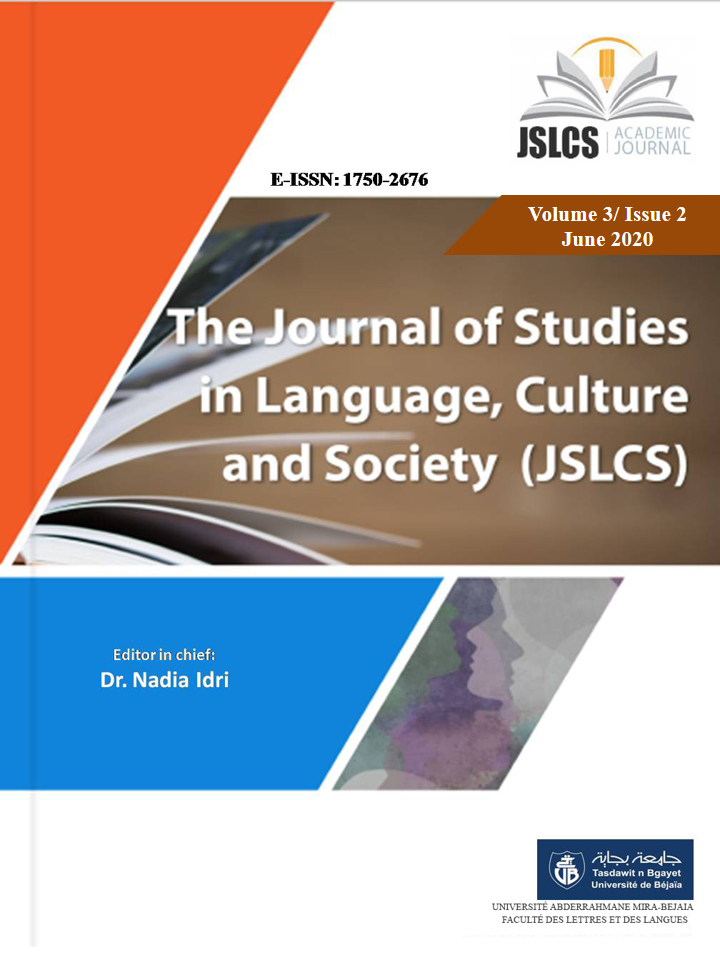Using Films As Teaching Materials In The Course Of Civilization: Teachers’ And Learners’ Perspectives
Keywords:
Course of civilization, film, culture learning, critical thinking, foreign language classroomAbstract
This paper aims to examine students’ and teachers’ perceptions of integrating films in the course of civilization as a means to reinforce the course objectives in terms of enhancing students’ culture learning and critical thinking at the Department of English of Bejaia University. Two research instruments were used for collecting data: students’ questionnaire to enquire about their perceptions and attitudes towards learning civilization with film and teachers’ interview to find out whether films have a place in their classes of civilization and their idea on the potential of film to teach civilization. The qualitative and quantitative data obtained reveal all the students and most of the interviewed teachers are in favour of integrating films in cultural instruction. Yet, there appears a mismatch between the students’ high interest in learning with multimedia and the traditional materials the instructors use in the classroom.
References
Briam, C. (December, 2010). Outsourced: Using a Comedy Film to Teach Intercultural Communication. Business Communication Quarterly. (73) 4, 383-398.
Bueno, K. A. (2009). Got film? Is it a readily accessible window to the target language and culture for your students? Foreign Language Annals, (42) 2.
Chambers, Gary.N. (1999). Motivationg Language Learners. Clevedon: Multilingual Matters LTD.
Champoux, J. E. (2007). Film as Teaching Resource. Journal of Management Inquiry 1999, 8 (2): 240-251. Updated: September 26, 2007.
Chao, Tzu-Chia. (2013). A diary study of university EFL learners’ intercultural learning through films. Language, Culture and Curriculum, (26) 3, 247-265.
Cook. G. D., Stout, D. F., & Dahl. R. C. (1988). Using Video to increase oral proficiency: A Model for Lehrerfortbildung. Teaching German. (12) 1.
Corbett, J. (2003). An Intercultural Approach to English Language Teaching. Clevedon: Multilingual Matters Ltd.
Donalghy, K. (2012). Film English. http://film-english.com/, accessed on 11/1/2012.
Ellis, R. (1994). The Study of Second Language Acquisition. Oxford: Oxford University Press.
Harisson, L. G. (December, 2009). Foreign Films in the Classroom: Gateway to language and Culture. Journal of College Teaching and Learning. (6) 8.
Herron, C., Corrie, C., Cole, S.P., & Dubreil, S. (winter, 1999). The effectiveness of a video-based curriculum in teaching culture. The Modern Language Journal, (83) 4, 518- 533.
Herron, C, Dubreil, S., Cole, S. P., & Corrie, C. (2000) Using instructional video to teach culture to beginning foreign language students. CALICO Journal, (17) 3, 395-427.
Herron, C, Dubreil, S, Corrie, C, & Cole, S.P.C. (2002). A classroom investigation/ can video improve intermediate-level French language students’ ability to learn about a foreign culture. The Modern Language Journal, (86) 1, 518- 533.
Ingram, M. (May, 2001). Interdisciplinary Perspectives in the French Civilization Class. The French Review. (47) 6, 1152-1164.
Michalczyck, J. J. (Dec. 1976). The Teaching of French Civilization through Film on the University Level. The French Review, (50) 2.
Michan, F. (2005). Designing authenticity into Language Teaching Materials. Portland: Intellect LTD.
Nait Brahim, A. (2006). The Ideological Horse in the Pedagogical Realm: Towards a Recovery of the Intellectual Spectrum. (Doctorate thesis), University of Oran.
Phelps, J. F. G. (2012). Teaching Cultural Analysis Using the Intercultural Film Database. Maryland Foreign Language Association. Fall Conference. At http://www.2014mflafallconference.wikispaces.com
Rollet, B. (1995). Le film de fiction dans la classe de civilisation. (Doctorate thesis), University of La Sorbonne, Paris, Frace.
Rollet, B. (1997). The Fiction Film in the Class of Civilization. Journal of Area Area Studies. (5) 11, 130-142.
Pegram, M. (2008). Film, culture, and identity: Critical intercultural literacies for the language classroom. Language and Intercultural Communication, 8(2), 136-154.
Walsh, J., and Reese, B. (1995). Distance Learning’s growing reach. Technological Horizons in Educational Journal. (22) 11, 58-62.
Wildner-Basset, M. E. (1990). A video visit to the land of them: Commercials and culture in the classroom. Teaching German, 23 (1), 54-60.
Zoreda, M. L. (2006) Intercultural moments in English teaching through film. Reencuentro. University of New Mexico.








